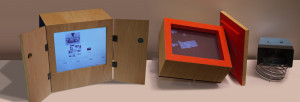Material artifacts are passed down as a way of sustaining relationships and family history. However, new issues are emerging as families are increasingly left with the digital remains of their loved ones. The Technology Heirlooms project explores how digital materials might be passed down, lived with and inherited in the future through the design and deployment of three robust tangible interactive systems: Timecard, Digital Slide Viewer, and BackupBox. Timecard is a device that enables people to assemble, present and hide away digital content of multiple family members along a chronological timeline. Digital Slide Viewer packages treasured family photo albums in the form factor of a traditional slide viewer. BackupBox locally stores a person’s Twitter archive on a daily basis in a form that can be handed down. The Technology Heirlooms project won the 2011 Silver IDEA award for Design Research from the Industrial Designers Society of America (IDSA).

The Timecard (right), BackupBox (center), and the Digital Slide Viewer (right).
In collaboration with colleagues at Microsoft Research Cambridge, I evaluated the Technology Heirlooms with eight households in the United Kingdom. Each of these systems embodies familial digital data in physical forms that enabled these archives to be opened up and experienced or packed away and simply lived with. This work revealed the critical need to support family members’ evolving social practices, roles, and representations as digital family archives change over time as they slowly accumulate new data and histories. Interestingly, participants widely valued the capacity to integrate digital archives alongside their material heirlooms, and often reflected on how this kind of ‘technology’ contrasted the ephemeral nature of many other technologies in their homes. These findings highly influenced my subsequent Photobox project.
Publications
Odom, W., Banks, R., Kirk, D., Harper, R., Lindley, S., Sellen, A. (2012). Technology Heirlooms? Considerations for Passing Down and Inheriting Digital Materials. In Proceedings of SIGCHI Conference on Human Factors in Computing Systems. Austin, Texas. CHI ’12. ACM Press, 337-346. (Local copy, ACM link)
Odom, W., Wakkary, R., Lim, Y., Desjardins, A., Banks, R., Hengeveld, B. (2016). From Research Prototype to Research Product. In Proceedings of SIGCHI Conference on Human Factors in Computing Systems. San Jose, USA. CHI ’16. ACM Press.
William Odom, Daisuke Uriu, David Kirk, Richard Banks, Ron Wakkary. (2018). Experiences in Designing Technologies for Honoring Deceased Loved Ones. Design Issues, 31, 1, 54-66 MIT Press.
Related Links
Computer scientists grapple with how to manage the digital legacy of the departed (interview with Science News)